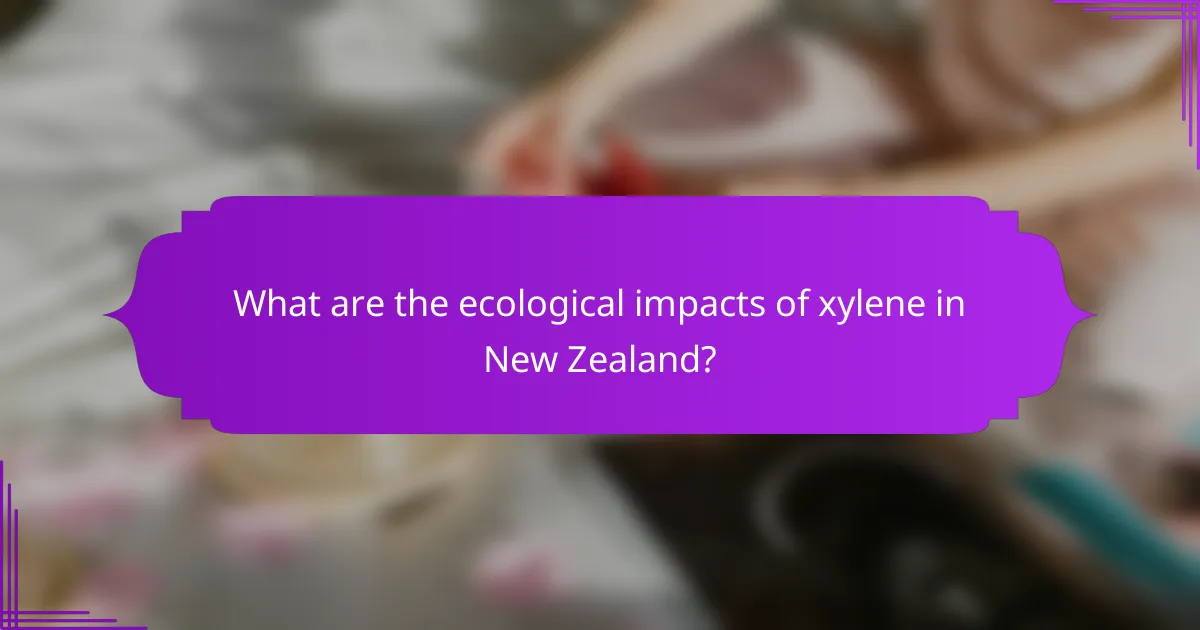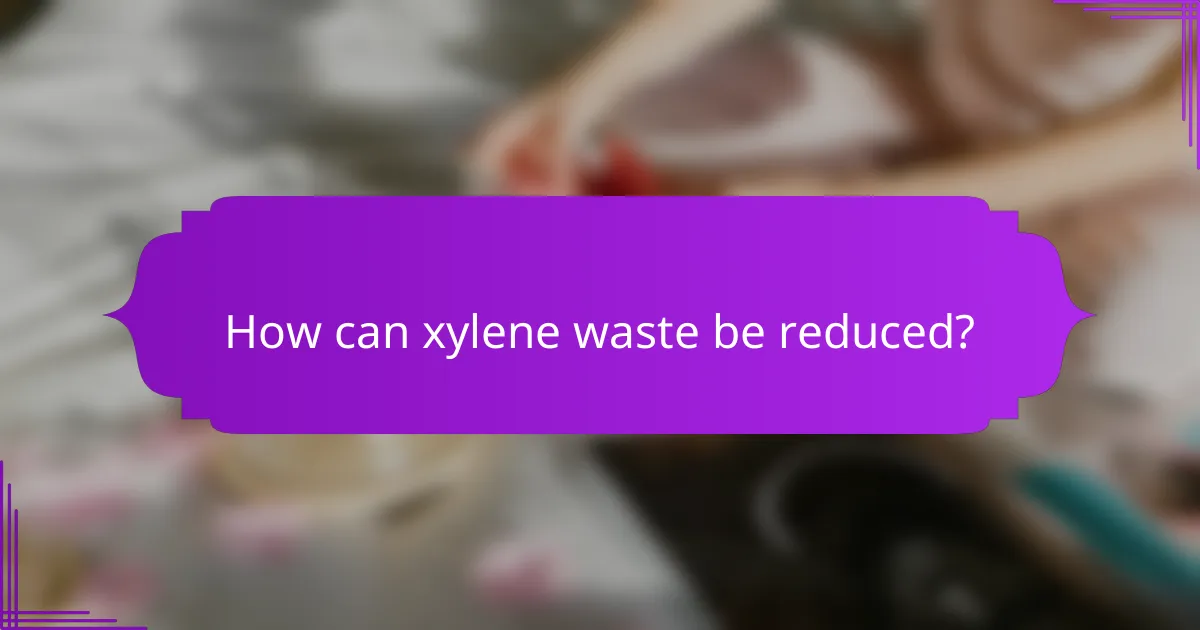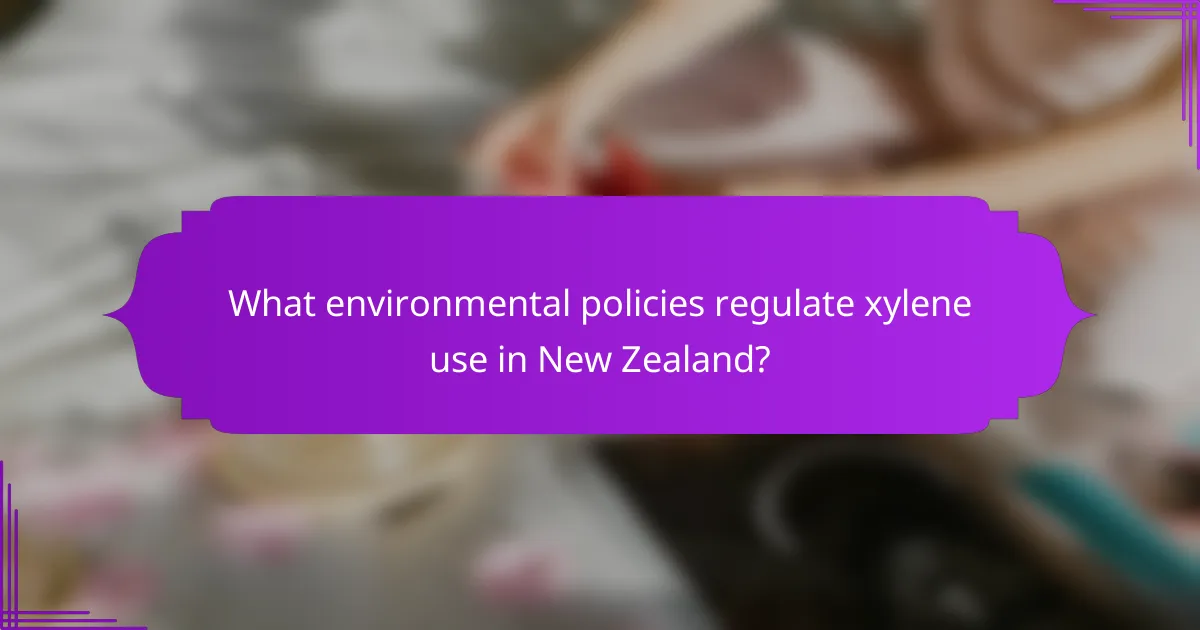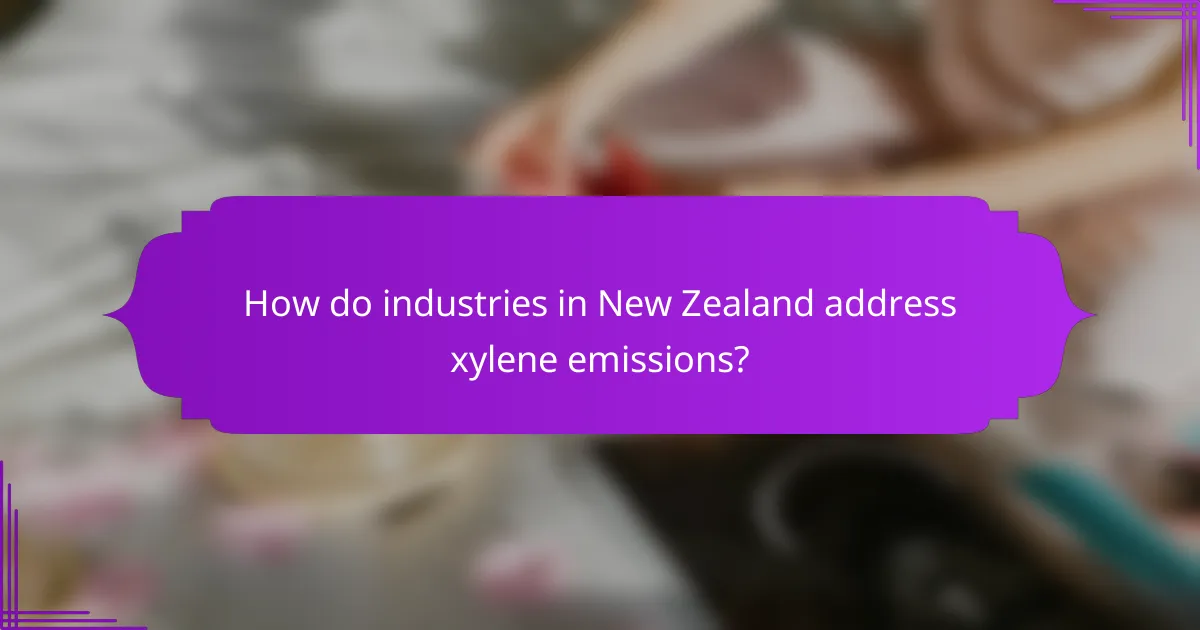Xylene poses significant ecological challenges in New Zealand, impacting air quality, water sources, and local ecosystems, with implications for both human health and biodiversity. To mitigate its environmental footprint, effective waste reduction strategies such as recycling programs and green chemistry practices are essential. Additionally, stringent environmental policies regulate xylene use, ensuring safe handling and disposal to safeguard public health and the environment.

What are the ecological impacts of xylene in New Zealand?
Xylene has significant ecological impacts in New Zealand, primarily affecting air quality, water sources, and local ecosystems. Its emissions and potential for contamination pose risks to both human health and biodiversity.
Air pollution from xylene emissions
Xylene emissions contribute to air pollution, which can lead to respiratory issues and other health problems for humans and animals. In urban areas, the concentration of xylene can exceed safe levels, particularly near industrial sites and heavy traffic zones.
New Zealand’s air quality standards set limits for volatile organic compounds (VOCs), including xylene. Monitoring and regulating these emissions is crucial to maintaining healthy air quality, especially in populated regions.
Water contamination risks
Xylene can contaminate water sources through runoff from industrial sites or spills, posing risks to drinking water supplies and aquatic ecosystems. Even small amounts of xylene can be toxic to fish and other aquatic organisms.
In New Zealand, regulations require proper handling and disposal of hazardous substances to minimize water contamination. Regular assessments of water quality near industrial areas are essential to detect and address potential xylene pollution.
Effects on local wildlife
The presence of xylene in the environment can adversely affect local wildlife, particularly species that rely on clean water and air. Exposure to xylene can lead to behavioral changes, reproductive issues, and even mortality in sensitive species.
Conservation efforts in New Zealand focus on protecting vulnerable habitats and species from the impacts of pollution, including xylene. Implementing best practices in waste management and industrial processes can help mitigate these effects on wildlife.

How can xylene waste be reduced?
Reducing xylene waste involves implementing effective strategies that minimize its production and enhance recycling efforts. Key approaches include recycling programs, green chemistry practices, and the use of alternative solvents.
Implementing recycling programs
Recycling programs for xylene can significantly reduce waste by reclaiming and reusing solvents. Facilities can set up closed-loop systems where xylene is collected, purified, and reused in the same processes, minimizing the need for fresh solvent and reducing environmental impact.
Establishing partnerships with recycling companies can facilitate the proper disposal and recycling of xylene waste. Regular audits of waste streams can help identify opportunities for recycling and improve overall waste management practices.
Adopting green chemistry practices
Green chemistry practices focus on designing chemical processes that reduce hazardous substances, including xylene. By using safer, less toxic alternatives in formulations, companies can lower their reliance on xylene and decrease waste generation.
Training staff on green chemistry principles can enhance awareness and encourage innovative solutions to minimize xylene use. Implementing process modifications, such as optimizing reaction conditions, can also lead to reduced xylene consumption and waste.
Utilizing alternative solvents
Switching to alternative solvents can effectively reduce xylene waste. Solvents like ethanol, propylene glycol, or water-based solutions may serve as substitutes in many applications, offering lower toxicity and environmental impact.
When considering alternative solvents, it’s essential to evaluate their performance, cost, and compatibility with existing processes. Conducting pilot tests can help determine the most suitable alternatives while ensuring compliance with relevant environmental regulations.

What environmental policies regulate xylene use in New Zealand?
In New Zealand, xylene use is regulated by several key environmental policies aimed at minimizing its ecological impact. These regulations ensure safe handling, storage, and disposal of xylene to protect public health and the environment.
Resource Management Act 1991
The Resource Management Act 1991 (RMA) is a fundamental piece of legislation that governs the use of natural and physical resources in New Zealand. Under the RMA, activities involving xylene must be assessed for their environmental effects, requiring resource consents for significant uses or discharges.
Organizations must demonstrate that their use of xylene will not adversely affect the environment, including air and water quality. This can involve conducting environmental impact assessments and adhering to consent conditions that limit emissions and waste.
Hazardous Substances and New Organisms Act
The Hazardous Substances and New Organisms Act (HSNO) regulates the importation, manufacture, and use of hazardous substances, including xylene. This act requires that any hazardous substance is assessed for its potential risks to human health and the environment before it can be used.
Under HSNO, xylene must be classified according to its hazardous properties, and users must comply with strict handling and storage guidelines. This includes proper labeling, safety data sheets, and training for personnel who work with the substance.
Local council regulations
Local councils in New Zealand may implement additional regulations regarding xylene use, tailored to their specific environmental conditions and community needs. These regulations can include restrictions on where xylene can be stored or used, as well as requirements for reporting and monitoring emissions.
Businesses should consult their local council to understand any specific regulations that may apply to their operations involving xylene. Compliance with these local rules is essential to avoid penalties and ensure community safety.

What are best practices for xylene management?
Best practices for xylene management focus on minimizing environmental impact and ensuring safe handling. Implementing effective storage, training, and auditing procedures can significantly reduce risks associated with xylene use.
Proper storage and handling procedures
Proper storage of xylene involves using designated containers that are compatible with the chemical. These containers should be stored in well-ventilated areas away from heat sources and incompatible materials to prevent accidents.
Regular inspections of storage facilities are essential to identify leaks or deterioration. Utilizing secondary containment systems can further mitigate risks of spills and environmental contamination.
Employee training programs
Training programs for employees should cover the hazards associated with xylene, safe handling practices, and emergency response procedures. Regular refresher courses can help maintain awareness and compliance with safety protocols.
Hands-on training sessions can enhance understanding and retention of safety measures. Providing clear guidelines and resources can empower employees to act responsibly and effectively in case of an incident.
Regular environmental audits
Conducting regular environmental audits helps identify potential areas of improvement in xylene management practices. These audits should assess compliance with local regulations and evaluate the effectiveness of current safety measures.
Audits can include reviewing storage conditions, employee adherence to protocols, and the effectiveness of spill response plans. Implementing findings from audits can lead to enhanced safety and reduced ecological footprints.

How do industries in New Zealand address xylene emissions?
Industries in New Zealand tackle xylene emissions through a combination of advanced technologies, collaborations with environmental groups, and active participation in sustainability programs. These efforts aim to minimize the ecological footprint of xylene while adhering to local regulations and standards.
Implementation of emission control technologies
New Zealand industries utilize various emission control technologies to reduce xylene emissions effectively. Common methods include vapor recovery systems and scrubbers, which capture and neutralize harmful vapors before they enter the atmosphere. By investing in these technologies, companies can lower their emissions significantly, often achieving reductions of 30% to 50% in xylene output.
Regular maintenance and upgrades of these systems are crucial to ensure optimal performance. Industries are encouraged to stay informed about the latest advancements in emission control to enhance their environmental compliance and operational efficiency.
Partnerships with environmental organizations
Collaborating with environmental organizations is a key strategy for New Zealand industries to address xylene emissions. These partnerships often involve sharing best practices, resources, and research to develop more effective emission reduction strategies. Organizations such as the New Zealand Environmental Protection Authority (EPA) provide guidance and support to help industries align with national environmental goals.
Such collaborations can also lead to community engagement initiatives, raising awareness about xylene emissions and their impact. By working together, industries and environmental groups can foster a culture of sustainability and responsibility.
Participation in sustainability initiatives
Many industries in New Zealand actively participate in sustainability initiatives aimed at reducing their overall environmental impact, including xylene emissions. Programs like the New Zealand Emissions Trading Scheme (ETS) incentivize businesses to lower their carbon footprint, which indirectly benefits xylene emission reduction efforts.
Additionally, companies often set internal sustainability goals, such as achieving zero waste or reducing emissions by specific percentages within a set timeframe. These initiatives not only help in compliance with regulations but also enhance corporate reputation and customer trust.


